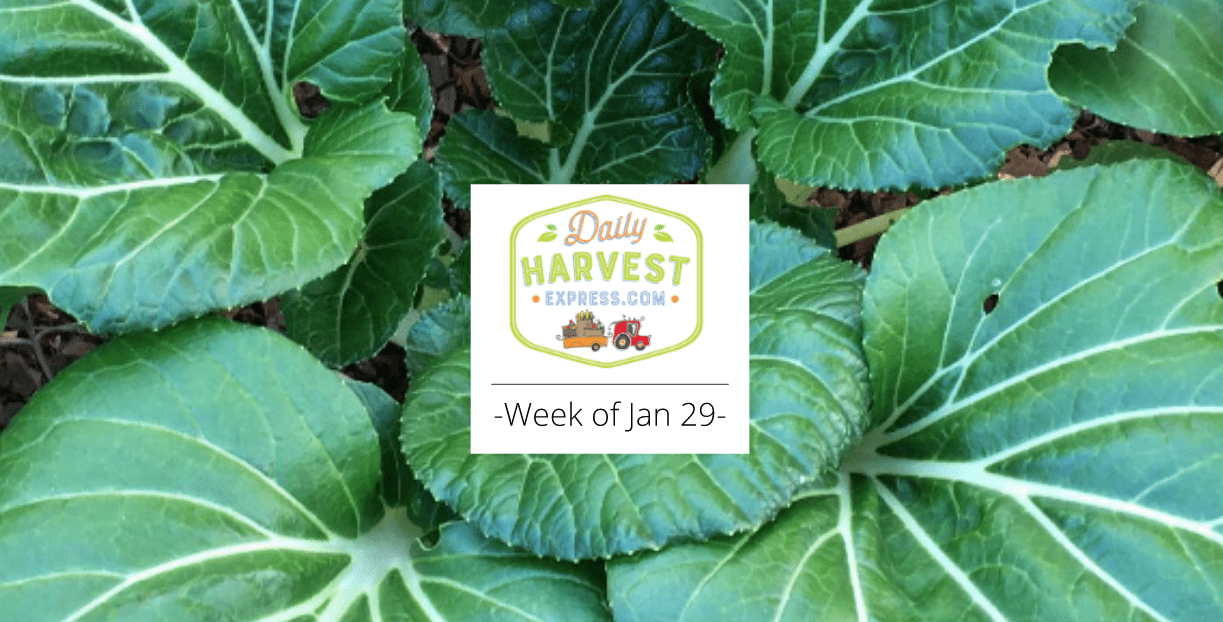What’s ahead for the week of January 29 – Feb 2? You can see exactly what’s coming in our pre-packed farm boxes on the What’s In My Box page. You can also go to our Build A Box to customize your order. Below are the highlighted items from our network of local farms:
- Bacon avocados, Garnet yams, Meyer lemons, and spaghetti squash from Stehly Farm;
- Basil, Persian cucumbers, and cherry tomatoes from Dassi Farms;
- Brussels sprouts and sugar snap peas from Gaytan Farm;
- Lettuce from Sundial Farm;
- Pink lady apples and Cara Cara oranges from Sweet Tree Farms;
- Kumquats and Gold nugget tangerines from Rancho Del Sol;
- Beets, carrots, dino kale, and bok choy from Be Wise Farm;
Where Does Bok Choy Come From?
Do you ever wonder about where a fruit or veggie on your plate came from? Not just the farm that grew it, but where in the world it originated?
Most foods have fascinating histories to share, and bok choy wants to share its story with you…

Bok choy (center) is closely related to broccoli, mustards, and other plants in the Brassica family.
In Cantonese, the primary language of China, “bok choy” simply means “white vegetable,” even though it comes in a wide range of colors. As its name implies, bok choy is indeed native to China, specifically the Yangtze River Delta area, one of the oldest and most famous agricultural regions in the world. Bok choy was likely bred from native wild brassica species growing in the area around 3,500 years ago!
In the 1300s CE, bok choy was imported to Korea, which was one of the most powerful and advanced societies in Asia at the time. During this era, Koreans created a fermented bok choy dish that is still renown today: kimchi.
In the 1500s, the famed Chinese scientist Li Shizhen (1518-1593 AD), popularized bok choy for its medicinal benefits in his seminal book, Compendium of Materia Medica (“Bencao Gangmu”). From then on, bok choy became enormously popular throughout China.
As it turns out, Li Shizhen was right! Modern science is indeed proving that bok choy isn’t just a tasty food, it’s also a medicinal powerhouse.
How to Eat Or Store Bok Choy
There are thousands of cooked and raw dishes that utilize bok choy, so don’t be shy about trying new ways to cook it. Bok choy is also perfect for fermenting into homemade European-style sauerkraut or Korean kimchi!
If you’re in a rush, the fastest way to make bok choy is chopped in a stir fry. Put a wok or other pan on medium high heat with a dash of good high heat oil (such as grapeseed, avocado, peanut, or safflower oil) to prevent sticking. Add chopped bok choy, diced garlic, and a sprinkle of sea salt and stir continuously to ensure the greens and garlic don’t burn. Don’t overcook your bok choy! Shortly after the green leafy parts have wilted, remove the pan from heat, add a dash of sesame oil (a lower heat oil) for flavor and sprinkle on some sesame seeds, then place the greens in a serving dish. You want the stems to be slightly crunchy, not mushy. This is one of the best ways to get a sense of the subtle delicate flavors of bok choy. If you want to ramp up the flavor or heat, simply drizzle on a spicy Asian sauce before serving. Here’s a recipe you can try!
If you’re not going to eat your bok choy right away, store it in a plastic bag in the crisper drawer in your refrigerator for up to one week or more.
Order Now!
Get your Daily Harvest Express order placed right now (or no later than Sunday evening at 5 pm) so you can enjoy another week of fresh, healthy food from local farmers!
Order Now
Want to get more articles like this?
Subscribe to our weekly newsletter to get more local food & farming news from Daily Harvest Express!

